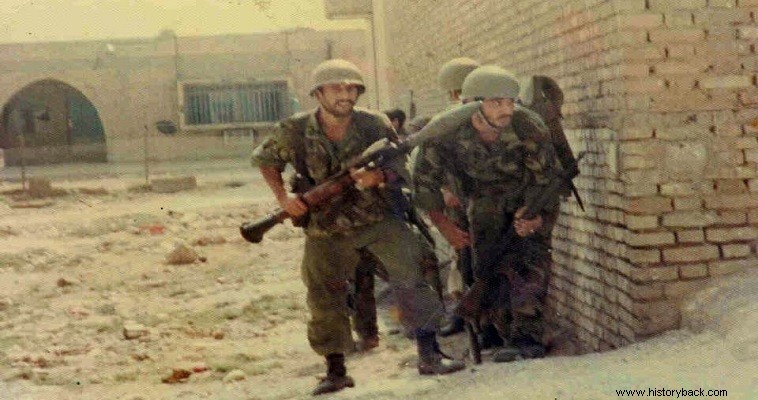
The Battle of Horamshar was one of the biggest, most important, toughest and fiercest of the Iran-Iraq war. It is not by chance that Khoramsar received the nickname "city of blood". By 1979 the Iranian city of Khoramsar had 220,000 prosperous residents.
The city was the main port of the country. After the "Islamic Revolution" anti-government groups in the city turned to Iraq for support while at the same time the city was rocked by terrorist attacks that were a prelude to what was to follow.
On September 17, 1980, he announced Iraq's withdrawal from the Treaty of Algiers, which settled border disputes. On September 22, the Iraqis invaded. Leading the charge was their reinforced 3rd Armored Division with two armored brigades, a motorized brigade and six special forces battalions.
Also used was the 5th Mechanized Division, elements of which reinforced special forces battalions, elements of the 2nd Infantry Division, a commando battalion of the "Democratic Guard" and paramilitary forces. In total, the Iraqis threw into the battle about 20,000 men who were supported by 600 pieces of artillery.
On the other hand, the Iranians had about 3,000 men – a motorized battalion, a garrison battalion, a battalion of naval special forces, Revolutionary Guards and volunteers. The Iranians also had some Chieftain tanks.
The Iranians had evacuated the city of the civilian population and organized three lines of defense. The first was manned by regular units, in the second the artillery and armored units were deployed and in the third were volunteers.
Attack
The Iraqi invasion of Iran began on the afternoon of September 22, 1980 with a series of airstrikes while artillery began pounding the area. The Iraqis advanced reaching the outskirts of the town which was only 10 km from the border. During this phase Iranian civilians who had not left were murdered.
By nightfall 500 Iraqi tanks had advanced along the Khoramsar-Awaz road, effectively cutting off the city. The Iranian perimeter makeshift defenses fell relatively soon but not without the Iraqis taking significant losses in tanks and armored vehicles which they insisted on using in urban areas.
By the morning of September 23, the city was almost completely surrounded. However, the Iranians showed no signs of slowing down. It took a week of fierce fighting for the Iraqis to capture the city's outer defensive zone.
On September 30, 60 Iraqi commandos managed to infiltrate the city, but were driven out. But soon the Iraqis came back reinforced with tanks and armored vehicles. The Iraqis attempted to capture the railway station, the barracks and the slaughterhouses of the city.
The Iranians were waiting for them with every available weapon and Molotov cocktails . Iraqi casualties were heavy but they gradually began to prevail due to numbers. Then the Iranian Chieftains intervened and the Iraqis were repulsed.
New fierce attacks resulted in their capture of the slaughterhouses and the railway station, but only for a short time. An Iranian counterattack pushed them out of the city.
Continuous attacks
After this defeat the Iraqis better organized their next attack which was launched on 11 October. In the intervening 10 days their artillery and air force pounded the city fiercely. By October 14, the Iraqis had managed to get back inside the city, gradually neutralizing the Iranian tanks and pockets of resistance.
On October 16, the Iraqis took control of the port and the barracks and approached the center of the city where the great mosque was - the headquarters of the Iranians. Clashes went from house to house to house, floor to floor with Iranians fighting even with knives.
In this way and at a terrible cost in blood, the Iraqis arrived, on October 21, in the center of the city, attempting to capture the governorate and the bridge that connected the city to Abadan. The objectives in question had to be captured within 48 hours and for this reason the mission was undertaken by five battalions of Iraqi commandos.
On October 24 the attack was launched . The bridge was captured after five hours of fierce fighting, but in the governorate the battle lasted longer. In the afternoon the Iraqis managed to enter the building, but were driven out. With a new attack, at night, they finally managed to figure it out.
Now there were no more than 300 defenders alive and only the great mosque was holding. It was clear that they could not hold out for long so on the night of October 25-26 the surviving Iranians managed to escape via the Karun River.
Bands of fanatical Revolutionary Guard youth remained however and continued to fight desperately until 10 November. The losses of the victors were heavy. The Iraqis had 7,000 dead and wounded, while they also lost over 200 tanks and armored vehicles.
The losses of the Iranians were comparable, but to them must be added the thousands of civilians who were murdered in the first hours of the invasion.
